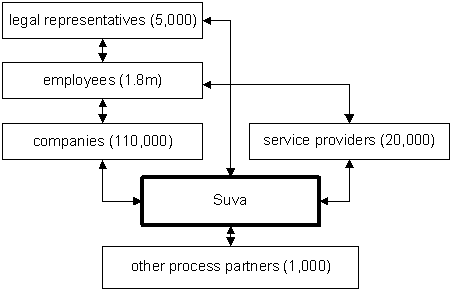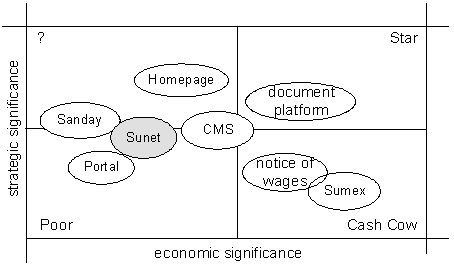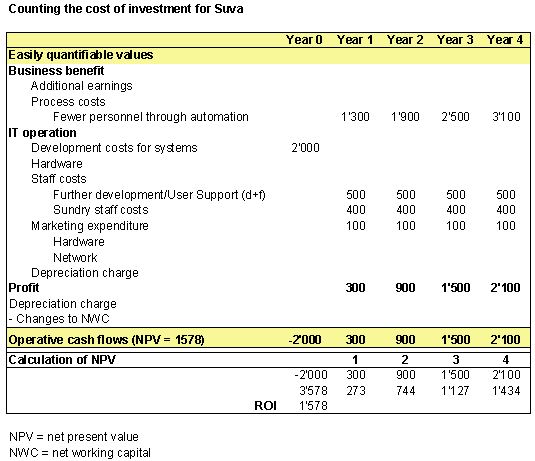Suva networks healthcare
This case study show how efficiency gains were achieved in the Suva company network with modern aids. Suva acts as organiser in this network and makes targeted investments in networking processes between the market players.
Inhaltsverzeichnis
1. Suva2. The network
3. Clear internal responsibility and coordination
E-Business, Investments
4. Suva as the driving force in the network
First mover, Industry standard
5. E-Business pays off
Processes, Electronic accident form
6. Prioritising projects
Project portfolio
7. Calculating profitability
Profitability, the price of investment
8. Challenges
9. Conclusion
1. Suva
Suva (short for Swiss National Accident Insurance Organisation) insures companies primarily from the second economic sector[2] against the effects of occupational and non-occupational accidents and occupational illnesses. As an independent public sector company, it provides services in prevention, insurance and rehabilitation.
between the players in healthcare.”
(Beat Arnet, Head of Distribution at Suva) [1]
Suva’s earnings are from insurance premiums and financial investments. In the financial year 2002 it generated 5.2 billion Swiss francs with 2,450 employees in 20 agencies. It insures almost 110,000 businesses with 1.8 million employees.

Figure 1: Suva network as in the example of SuvaCare.
2. The network
Three processes characterise Suva:
- Prevention (SuvaPro): Businesses seek to reduce staff absences as a result of occupational and non-occupational accidents. SuvaPro develops measures to promote accident prevention and health protection in enterprises. SuvaPro reduces non-occupational accidents through campaigns, guidance and training for safety officers.
- Insurance (SuvaRisk): SuvaRisk insures companies and administers their capital assets.
- Accident claim handling (SuvaCare): SuvaCare attends to patients’ needs from the accident report to rehabilitation. Suva coordinates the accident care rendered by the medical service provider Suva owns two rehabilitation clinics.
Suva works with third parties in all three processes. In each case it acts as market maker. It makes targeted investments in networking its process partners in order to improve overall efficiency.
Taking SuvaCare as an example, Fig. 1 shows how many partners are represented in the network. Changes to the business processes between the partners must always take into account all parties’ economic exigencies. Suva accepted this challenge.
3. Clear internal responsibility and coordination
At Suva, e-business is understood to mean all data flowing to and from its partners and customers. Organisation of these data flows is established both centrally and locally.
- Centrally: Under the leadership of Beat Arnet the Distribution department provides services for the core processes in management and support. Five people are employed for this task. They coordinate all Suva’s e-business activities. The Distribution department is responsible for defining basic cross-process conditions. The Distribution department takes over leadership of cross-process projects.
- Locally: Suva’s internet projects are mainly spurred on by the process coordinators. Accordingly, responsibilities for most e-business activities are settled locally.
In the past, the project coordinators hired external service providers to speed up development of ad hoc solutions. Nowadays, precise information is available on the applications of significance so that these partial solutions are now integrated. Beat Arnet developed two measures to effect this. On the one hand, the number of suppliers is reduced while, at the same time, the internal IT department takes on more tasks in application development.
As part of this integration, the Distribution department advises the project coordinators in their role coordinating the creation of synergies, and as motivators and technology scouts to ensure the company continues to be taken seriously as a market maker.
Suva seeks to strategically and operationally safeguard its investments by means of the following three measures:
a. The IT Commission manages a budget of CHF 70 million for developing and operating the IT infrastructure (incl. staff costs). Under the lead of the executive chairman it prioritises all IT projects. This ensures that means are deployed in line with the target.
b. Activities are coordinated every three months or so in meetings with the project coordinators in an effort to avoid duplication.
c. The CMS user group is responsible for coordinating the editors and inputting the content on the website. This ensures that content is reusable and that web communication is orientated towards serving the Suva strategy.
4. Suva as the driving force in the network
It is less likely that Suva will be effective in ensuring efficient use of e-business between the network partners through coordination meetings and top-down management. Rather, it must use the applications’ economic advantages in its arguments to convince partners. Networking in healthcare is particularly difficult. Doctors, hospital, health insurers and companies use new information and communication system to varying degrees of intensity. To overcome these hurdles, Suva is standardising inter-company data interchange. While it has already rationalised its internal processes to a great extent, media gaps still exist between participating organisations.
As a first mover, Suva has the chance to set an industry standard. It employs various measures to motivate partners to cooperate.
- To promote integration, it makes software available to software companies so that they can integrate it in software for service providers.
- It licenses software to various health insurers for integration.
- Suva persuades its partners in many personal conversations of the common success of these measures bring.
5. E-Business pays off
Suva thoroughly analyses the processes before it invests in software to support inter-company business processes. The greatest potential for rationalisation is assumed to be where the most data accumulates. Therefore Suva analyses data volumes in each process. The analysis showed the largest potential in treatment-cost invoicing and accident reports in the SuvaCare process. Both processes are not only integrated at Suva but also at the process partners, too.
1.5 million medical invoices
In the past, Suva invoiced 20,000 services providers on paper. This required the invoices to be input manually at Suva. The move towards electronic invoice transmission was prompted by the introduction of TARMED, the new tariff structure. Doctors could no longer cope with the 4,600 service items in TARMED[3] . Suva therefore provided doctors with the Sumex I application to enable them to generate their invoices electronically. The application serves to validate the invoice according to Tarmed and transmits it to Suva. This means manual input at Suva is no longer necessary and errors can be reduced. Sumex I is supplied free of charge to software companies that produce programs for doctors. This safeguards integration into doctors’ existing office automation. At the same time, the Sumex II module ensures integration at Suva. This module is also licensed to other health insurers. Through this project, Suva positioned itself as first mover in standardising data interchange between service providers and insurers. The standard has spread rapidly through licences to other health insurers.
470,000 accident reports
In the past, companies ordered accident forms from Suva. They sent the hand-completed forms to Suva by post. Manually recording accident reports at Suva took a great deal of time. Today companies have two channels by which to send electronic accident forms to Suva: Sunet as client software and SunetWeb for the electronic report via the internet. This circumvents the media gap and manual data input
6. Prioritising projects
Project proposals are formulated as soon as it can be shown that potential for rationalisation exists. Before investing, the IT Commission evaluates each project according to its “contribution to the financial result” and “strategic position”.
At present, Suva has very few projects that are distinguished by both a high strategic position and a substantial contribution to the financial result (star). Beat Arnet realises that e-business does not immediately produce the desired success: “We have several products with strategic significance but with only a moderate contribution to the financial situation (Sumex, electronic accident form). Only three projects are cash cows.” The problem is the relatively high costs that come with e-business. [project portfolio]

Figure 2: The Suva project portfolio
7. Calculating profitability
The complexity of calculating the profitability of an e-business project should not be underestimated. Suva makes a detailed inspection of each, as illustrated by the Sunet project.
By transmitting accident forms electronically, Suva can save 15 minutes on each case. Counter-enquiries where details are missing or comprehension difficulties arise reduce the time saved to an average six minutes per case. At present, 30% of the 470,000 accidents are reported electronically, equating to 141,000 electronic accident forms. Through this measure, Suva saves 14,100 hour a year, corresponding to nine full-time positions.
The rationalisation effect will also grow with the expected increase in use rates of Sunet in the next five years .

Figure 3: Net present value (NPV) of Sunet (figures in thousands).
In the first year, automation resulted in savings of CHF 1.8 million. Fig. 3 shows the calculation of the net present value (NPV) of the Sunet project. Suva can expect a positive NPV for this project, especially since it allows it to concentrate more closely on raising customer benefit.
With extensive services in new case management, for example, Suva can provide better care for accident victims who require intensive and comprehensive assistance. Besides medical matters, Suva also supports professional reintegration.
Success mainly depends on use by its partners. Through its sensitisation measures and the issue of licences and free software, Suva hopes to achieve a great degree of penetration in the shortest time. Only then will the investments pay off. Yet at the same time Suva is helping the entire industry towards a new cost structure through the efficient organisation of inter-company data interchange. This strengthens Suva’s and its partners’ market positions.
8. Challenges
Beat Arnet stresses that Suva cannot rest on its laurels. Hence, besides raising efficiency by networking partners, he is also considering new services. New services will in turn produce advantages for Suva and its partners.
Mobile devices and the internet can already be used to request locations of service providers in healthcare. This software (Sanday) can find the nearest doctor’s surgery or hospital within a few seconds. Sanday was only made possible by cooperating with professional healthcare associations and bodies. For example, Suva has convinced the Swiss Association of Pharmacists, the Swiss Society of Dental Surgeons and the Swiss Society of Veterinary Surgeons of the point of the application.
Sanday also serves as a technical and organisational platform for another project Beat Arnet is currently working on. The allocation of patients to hospitals is made considerably easier by the internet-supported bed management system used by Berne Canton. The number of free beds is recorded in the hospitals. Via 144, Berne Canton’s emergency medical number, doctors access the data to find the right hospital for their patients. That saves them time and ensures that capacities are better balanced in the hospitals. Both save costs.
A great deal of persuasion is required to get partners to participate. The usage rate of Suva’s e-products must be high to realise effects of scale.
However, many ideas also face technical hurdles: the security of data transmission and above all partner authentication are important. A PKI is required to exchange information mutually. Because no certificates are being issued by public agencies, Suva is thinking of establishing its own certification. Now, however, it has decided not to undertake this itself because it appears that investments would far outweigh benefits. Pending availability of a public PKI, Suva is backing cheaper solutions.
9. Conclusion
Suva has taken over the role of network organiser in healthcare. It promotes the networking of business processes with its partners. At the same time, it initiates various discussions on the design of inter-company processes: it analyses which processes benefit most from electronic support. Together with its partners it discusses which processes should be selected for networking. The choice of processes automatically determines the partners in the network. Finally, the partners jointly lay down the distribution of functions and resources. They assign tasks and responsibilities in the network. After that the partners develop rules to facilitate cooperation and jointly discuss incentive systems that reward long-term use for the collective. In incorporating its partners, Suva evaluates the benefit for each one.
[1] This case study is based on an interview given by Beat Arnet to Nicole Scheidegger on 4th June, 2003.
[2] Manufacturing sector, industry, structural and civil engineering and the extractive industry.
[3] TARMED is the new tariff listing individual services that will apply to all out-patient services in hospitals and surgeries. The Swiss government approved the TARMED 1.1r tariff structure in 2002. Accident, military and disability insurers began introduction of TARMED on 1st May, 2003. From 1st January, 2004, TARMED will be applied across the whole country. See www.tarmedsuisse.ch, 17th June, 2003.




